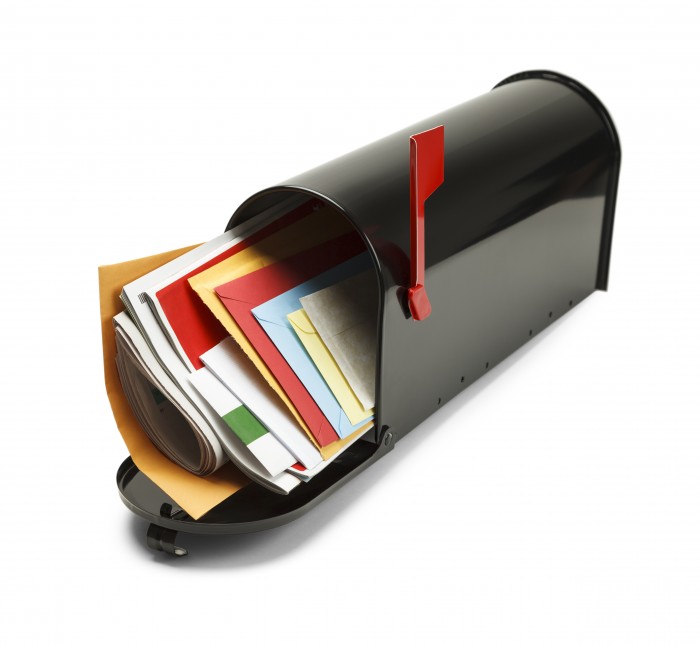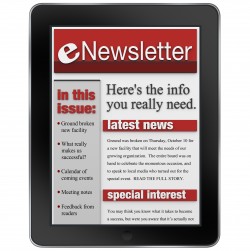 Most email marketers are fully aware of the benefits – and the challenges – of an e-newsletter. These regularly scheduled email messages go on a daily, weekly, monthly, or quarterly basis. (I don’t know anyone who has a yearly email newsletter, but I guess it’s possible.) They’re usually filled with feature stories (or short blurbs that lead to longer articles online) and generally don’t have a “hard sell” call to action, although selling or customer retention is usually the ultimate goal.
Most email marketers are fully aware of the benefits – and the challenges – of an e-newsletter. These regularly scheduled email messages go on a daily, weekly, monthly, or quarterly basis. (I don’t know anyone who has a yearly email newsletter, but I guess it’s possible.) They’re usually filled with feature stories (or short blurbs that lead to longer articles online) and generally don’t have a “hard sell” call to action, although selling or customer retention is usually the ultimate goal.
There are many reasons these newsletters keep showing up in your inbox:
- They can be fantastic vehicles for engagement, putting your brand in front of your customers and prospects on a regular basis.
- They set your organization up as a leader in your field or industry. It’s your chance to showcase your resident experts, whether they’re technical geniuses or trend gurus.
- And of course, they give you a chance to regularly promote your products and services.
However plentiful the benefits may be, some email marketers find themselves sending out the latest issue of a newsletter just because it’s on the calendar (or because the boss expects it to go out), not because they’ve got something relevant or interesting to say.
Other marketers are reluctant to even launch a regular newsletter because they’re daunted by the amount of work involved. And that’s too bad, because 68% of marketers agree that e-newsletters are the best type of email messages to help to achieve their business goals – at least, according to the 2013 DMA National Client Email Report.
During my years as the editor and publisher of an email newsletter, I’ve found that there are several factors working against the regular delivery of relevant email newsletters.
- Too little time. Making sure a regular newsletter goes out regularly, on deadline, every time, is a challenge. Plus, when there’s no room to stop and catch your breath, there’s no time to test, redesign, and optimize your message.
- Lack of content: How do you find something new to say every time you have a newsletter to put together? Sure, you can count on seasonal features, depending on your industry, but fresh articles and new insights can sometimes be hard to get.
- No focus: Once you’ve got an email newsletter in place, stakeholders start coming out of the woodwork. Can you promote this discount program? Will you include an article from the CEO about a charity? It’s hard to say no – especially when you’re running low on content (and time).
So what does it take to start and maintain a compelling email newsletter program, and how can you make sure you’re getting the most value from the work you put into it? Here are five tips for making the most of a newsletter program.
1. Create an Editorial Calendar
 Knowing what’s going out when is a great way to spot gaps in your content strategy. You can make sure you’re hitting all the top focus areas while still making room for stakeholder content. When a piece of content doesn’t fit into the strategy, you’ll have a good reason for turning it down. An editorial calendar should include an outline of the content and images you’ll be running in each edition, along with who is responsible for delivering it, as well as reviewers, deadlines, and so on.
Knowing what’s going out when is a great way to spot gaps in your content strategy. You can make sure you’re hitting all the top focus areas while still making room for stakeholder content. When a piece of content doesn’t fit into the strategy, you’ll have a good reason for turning it down. An editorial calendar should include an outline of the content and images you’ll be running in each edition, along with who is responsible for delivering it, as well as reviewers, deadlines, and so on.
2. Develop an Executive Editorial Board
Getting stakeholders together in in a room, real or virtual, is a great way to get some alignment into the strategy. At least, in a perfect world, that’s the way it works. In the real world, it’s more likely you’ll get a bunch of people who never show up for meetings and who end up sending you content at the last minute, demanding that you run it in tomorrow’s issue. Avoid this problem with an editorial board, and make sure they have the power to veto last-minute additions – and call out people who miss their deadlines.
3. Design for Your Readers
 Pay attention to how your recipients read your messages. Optimize your design for mobile using responsive templates that adapt to the device being used. Use a service like Litmus (which is integrated with Act-On’s email composer) to see exactly how your message will look across different devices and email clients. In addition, you may want to keep the content short and drive readers online to read the whole article. It frees up your email for more topics, allows some breathing room (especially on mobile devices), and sends more traffic to your site.
Pay attention to how your recipients read your messages. Optimize your design for mobile using responsive templates that adapt to the device being used. Use a service like Litmus (which is integrated with Act-On’s email composer) to see exactly how your message will look across different devices and email clients. In addition, you may want to keep the content short and drive readers online to read the whole article. It frees up your email for more topics, allows some breathing room (especially on mobile devices), and sends more traffic to your site.
4. Make it Relevant
Everyone is busy these days, and the best way to make sure your newsletter gets read is to make it as relevant as possible. I’ve worked on newsletters that had thousands of different versions – all generated using dynamic content. It included this kind of customized content:
- Tech support and troubleshooting for recently purchased products
- Lifestyle features focused on the products owned. For a mobile phone, the recipient would get an article about extending battery life. The owner of an eBook reader would receive an article about new bestsellers available for download.
- A targeted upsell and cross-sell promotion. For example, “Here’s why your smart phone needs a protective case,” and, “Your universal remote control should really have a rechargeable battery.”
- Finally, there would be a geographically relevant feature. Readers in colder regions got an article about space heater safety tips. Readers in sunny climates saw information about portable air conditioners.
Of course, you might not have the time or the resources to find, create, or curate the many pieces of content it takes to support this level of customization. But even a single piece of content that’s personalized to the interests of your readers can go a long way to making them feel like your message is worth their time.
5. Test and Optimize
 Remember when I said that the relentless pace of newsletter publishing can often leave you no time to test, redesign, and optimize your message? Well, you can always do what I did – take some time off. Identify your slowest periods, if you have them, and use the time to go on hiatus for a week or a month, and test during this time.
Remember when I said that the relentless pace of newsletter publishing can often leave you no time to test, redesign, and optimize your message? Well, you can always do what I did – take some time off. Identify your slowest periods, if you have them, and use the time to go on hiatus for a week or a month, and test during this time.
Take advantage of the insights you’ve gained from testing to revise or completely redesign the newsletter – and be sure to test it again once you do. During the rest of the year, continually test small things, one at a time. Are text links better than buttons? Do pictures of people resonate more than photos of things? A simple A/B test can tell you a lot about your reader preferences and help you optimize results.
Don’t Do It Just to Do It
One more piece of advice: Figure out whether or not you really need a newsletter, because sometimes they aren’t the best way to achieve your business objectives. Track clickthrough rates, conversions, and revenue generated. See if unsubscribes jump after the latest issue goes out. You might be better served by (and your audience might be more receptive to) sending out bulletins as events warrant. Only when you look at the numbers can you know for sure. After all, email may be cheap, but it’s not free – especially when it has a negative impact on results.
